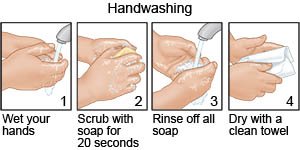Rheumatic Fever
Medically reviewed by Drugs.com. Last updated on Apr 6, 2025.
What is rheumatic fever?
Rheumatic fever is a condition that develops when a group A strep (GAS) bacterial infection is not fully treated. A GAS infection can cause strep throat, scarlet fever, and impetigo. Rheumatic fever is an autoimmune condition. This means your child's immune system overreacts to the bacteria and attacks healthy tissues. Inflammation forms in your child's joints, nerves, heart, and brain. Anyone can develop rheumatic fever, but it is most common in children 5 to 15 years old.
What are the signs and symptoms of rheumatic fever?
Any of the following may start 1 to 5 weeks after a GAS infection:
- A rash that has pink rings and a clear center
- Swollen joints, usually in the knees, ankles, elbows, and wrists
- Lumps near the affected joints
- Body movements that are not controlled or are jerky
- Chest pain or a heartbeat that is fast or not regular
- Fever or fatigue (mentally and physically tired)
- Joint pain
How is rheumatic fever diagnosed?
Your child's healthcare provider will examine your child. Tell the provider about your child's signs and symptoms. Also tell the provider if your child recently had strep throat or scarlet fever. The following may be used to confirm or rule out rheumatic fever:
- A throat swab is used to check for strep bacteria. Your child's provider will take a sample from the back of your child's throat. You may get the results in minutes or days.
- Blood tests are used to check for strep bacteria and signs of inflammation.
- Heart tests may be used to check for rhythm problems. The tests may also show heart inflammation or problems with the valves.
- A fluid sample from your child's swollen joint may be tested to find the cause of the swelling.
How is rheumatic fever treated?
- Antibiotics help treat the bacterial infection. Antibiotics may be given as a pill your child will take every day for 10 days. Your child may need monthly antibiotic injections for years to prevent rheumatic fever from coming back.
- Medicines may be given to help reduce your child's fever, pain, and inflammation.
Treatment options
The following list of medications are related to or used in the treatment of this condition.
What can I do to prevent rheumatic fever?
Rheumatic fever is not contagious, but GAS bacteria can be passed from one person to another. The following can help prevent rheumatic fever by preventing the bacteria from spreading:
- Always have strep throat, scarlet fever, or impetigo fully treated. Rheumatic fever can develop again, even after treatment. Take your child in to be tested for a GAS infection as soon as symptoms develop. Your child will need antibiotics to treat the infection. It is important to give every dose, even if your child feels better sooner.
- Wash your hands and your child's hands often. Teach your child to use soap and water. Wash for at least 20 seconds. Rinse with warm, running water for several seconds. Then have your child dry with a clean towel or paper towel. Children older than 2 years may use hand sanitizer that contains alcohol if soap and water are not available.

- Teach your child to cover a sneeze or cough. Have your child turn away from others and cover his or her mouth or nose with a tissue. Your child can use the bend of the arm if a tissue is not available. Then have your child wash his or her hands well with soap and water or use hand sanitizer. Your child should also turn and cover if someone nearby has to sneeze or cough.
- Have your child stay home when he or she is sick. Your child should not go to daycare, school, or work until his or her provider says it is okay. This is usually at least 24 hours after antibiotics are started. Your child will also need to have no fever for 24 hours without fever medicine.
- Clean wounds to prevent an infection. Wash your hands before and after you care for a wound. Clean the area with soap and water. Dry around the wound with a clean towel or paper towel. Put antibiotic cream or gel on the wound to prevent a bacterial infection. Cover the wound with a bandage. Change the bandage each day, and if it gets wet or dirty. If your child has impetigo, follow directions from healthcare providers for cleaning and covering the sores.
Call your local emergency number (911 in the US) if:
- Your child has trouble breathing.
When should I seek immediate care?
- Your child has new or worsening symptoms.
When should I call my child's doctor?
- You have questions or concerns about your child's condition or care.
Care Agreement
You have the right to help plan your child's care. Learn about your child's health condition and how it may be treated. Discuss treatment options with your child's healthcare providers to decide what care you want for your child. The above information is an educational aid only. It is not intended as medical advice for individual conditions or treatments. Talk to your doctor, nurse or pharmacist before following any medical regimen to see if it is safe and effective for you.© Copyright Merative 2025 Information is for End User's use only and may not be sold, redistributed or otherwise used for commercial purposes.
Further information
Always consult your healthcare provider to ensure the information displayed on this page applies to your personal circumstances.
